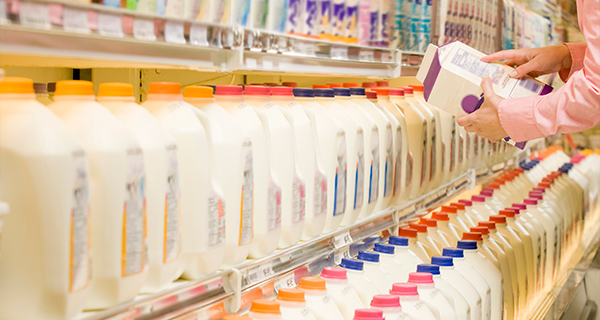Strolling down the aisles of the supermarket, shoppers encounter a barrage of claims on food cans, boxes, packages and shelf tags primarily touting what is absent from the product: gluten-free, sugar-free, fat-free, non-GMO, no added growth hormones, antibiotic-free and no artificial colors or preservatives. Likewise, they are confronted daily with warnings on the internet and social media to avoid products containing these ingredients or produced in these ways.
It seems that food manufacturers have moved away from promoting food based on taste, quality, price, enjoyment or nutritional value and, instead, use fear as a way to sell their products. Unfortunately, this can lead to avoiding perfectly safe and healthful foods – potentially compromising nutritional status and compelling shoppers to pay a premium for products sporting “absence” claims.
Here’s a closer look at the truth behind the top four fear-based label claims.
- Gluten-free. Here’s a claim that has stood the test of time – but not the test of facts. Gluten is simply a protein in wheat, barley and rye. It’s true gluten should be avoided by the less than 1% of the U.S. population with celiac disease and up to 6% who have a non-celiac gluten sensitivity. However, “gluten-free” has become a marketing tool for foods that do not and never have contained gluten. While it is only found in three grains, “gluten-free” is touted on products from chili peppers to popcorn to water. And an NPD survey found over 30% of people avoid gluten. The truth is, wheat provides an array of nutrients – including fiber, minerals, B vitamins, antioxidants and prebiotics – as well as most of the folic acid in the U.S. diet, a nutrient especially important in helping prevent birth defects during pregnancy. In fact, one study found that by eating folic acid-fortified grain products, 77% of low-income women could consume adequate folic acid – an important fact, considering that many women avoid the supplement due to cost.
- Antibiotic-free. This claim on milk, dairy products and meat is another appeal to fear to sell a product, not protect health. Any milk that tests positive for antibiotic residue cannot be sold for human consumption in the U.S. Milk is tested several times at the farm and processing plant to ensure there are no antibiotics. If antibiotic residues are found in milk at the farm or subsequent checkpoints, the entire tanker load is dumped and the farmer faces strict penalties. Likewise, the U.S. Food and Drug Administration (FDA) requires a withdrawal period after antibiotics have been administered to livestock or poultry before the animals are slaughtered and enter the food supply.
- No added hormones. Another marketing ploy, labeling poultry or pork with “no added hormones” often promotes fear by implying that poultry or pork without this label do contain added hormones. But the U.S. Department of Agriculture (USDA) prohibits hormone use in raising hogs and poultry. Therefore, the claim "no added hormones" cannot be used on the labels of pork or poultry unless a statement follows it reading, "Federal regulations prohibit the use of hormones."
- Non-GMO. Finally, non-GMO claims appear on products ranging from ketchup, vodka and carrots to cat litter, even though there are only 10 currently approved GMO crops in the U.S. These include field and sweet corn, soybeans, cotton, canola, alfalfa, sugar beets, papaya, squash, potatoes and apples. Non-GMO claims imply that foods produced through GMO agriculture are not safe or healthful, which is not true. The 2016 National Academy of Sciences’ report “Genetically Engineered Crops,” a scientific review of nearly 900 research and other publications, found no substantiated evidence of a difference in risks to human health, nutrition or the environment between commercially available GMO and conventional crops.
We are fortunate in the U.S. to have the safest food supply in the world because of regulations and oversight by government agencies, like the Environmental Protection Agency (EPA), FDA and USDA. Likewise, producer groups and other certifying agencies provide additional safeguards. Food plays a significant role in our lives and, most importantly, health and should not be a source of fear, frustration or confusion. Rather than focus on those fear-based claims on the front of food cans and packages, consumers should turn them around and check out the nutrition facts panel to see how the food contributes to their daily nutrient needs.




